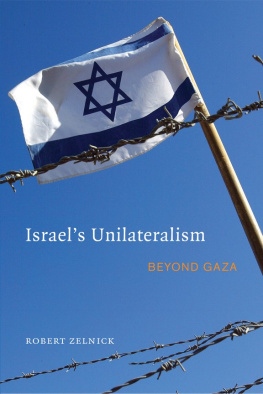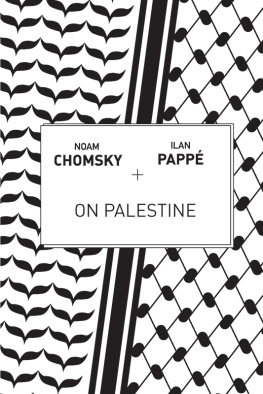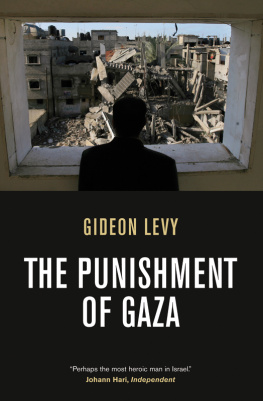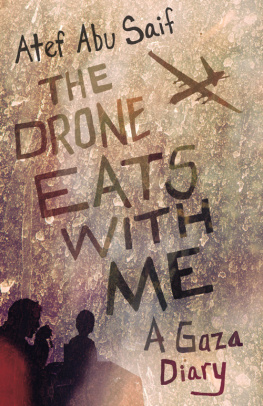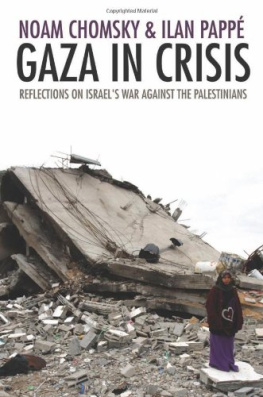Contents
2010 Noam Chomsky and Ilan Papp
First published by Haymarket Books in 2010
This edition published by Haymarket Books in 2013
P.O. Box 180165
Chicago, IL60618
773-583-7884
www.haymarketbooks.org
info@haymarketbooks.org
ISBN: 997-81-60846-3-541
Trade distribution:
In the U.S., Consortium Book Sales, www.cbsd.com
In Canada, Publishers Group Canada, www.pgcbooks.ca
In the UK, Turnaround Publisher Services, www.turnaround-uk.com
In Australia, Palgrave MacMillan, www.palgravemacmillan.com.au
All other countries, Publishers Group Worldwide, www.pgw.com
Cover design by Josh On. Cover photo of a Palestinian woman standing on the rubble of her home in the aftermath of Israeli bombing in January 2009 by Patrick Baz/AFP/Getty Images.
This book was published with the generous support of Lannan Foundation and the Wallace Global Fund.
Library of Congress Cataloging-in-Publication data is available.
10 9 8 7 6 5 4 3 2 1
One
The Ten Mythologies of Israel
Ilan Papp
Any attempt to solve a conflict has to touch upon its very core; the core, more often than not, lies in its history. A distorted or manipulated history can explain quite well a failure to end a conflict, whereas a truthful and comprehensive look at the past can facilitate a lasting peace and solution. A distorted history can in fact do more harm, as the particular case study of Israel and Palestine shows: it can protect oppression, colonization, and occupation.
The wide acceptance in the world of the Zionist narrative is based on a cluster of mythologies that, in the end, cast doubt on the Palestinians moral right, ethical behavior, and the chances for any just peace in the future. The reason is that these mythologies are accepted by the mainstream media in the West, and by the political elites there, as truth. Once accepted as a truth, these mythologies become a justification not so much for the Israeli actions, but for the Wests inclination to interfere.
Listed below are ten common myths that have provided an immunity and a shield for impunity and inhumanity in the land of Palestine.
Myth 1: Palestine was a land without people, waiting for the people without land
The first myth is that Palestine was a land without people waiting for the people without land. Its first part was successfully proved to be false by a number of excellent historians who showed that before the arrival of the early Zionists, Palestine had a thriving society, mostly rural but with a very vibrant urban center. It was a society like all the other Arab societies around it, held under Ottoman rule and part of the empire, but nonetheless one which witnessed the emergence of a nascent national movement. The movement would probably have turned Palestine into a nation-state like Iraq or Syria, had Zionism not arrived on its shores.
The second part of this mythology is also doubtful, but less significant. Several scholars, among them Israelis, doubted the genetic connection between the Zionist settlers and the Jews who lived during Roman times in Palestine or who were exiled at the time. This is really less important, as many national movements create artificially their story of birth and plant it in the distant past. The important issue, however, is what you do in the name of this narrative. Do you justify colonization, expulsion, and killing in the name of that story, or do you seek peace and reconciliation on its basis? It does not matter whether the narrative is true or not. What matters is that it is vile if, in its name, you colonize, dispossess, and in some cases even commit acts of genocide against indigenous and native people.
Myth 2: Palestinians resorted to acts of terror against Jewish settlers prior to the creation of Israel
The second foundational mythology was that the Palestinians, from early on, resorted to an anti-Semitic campaign of terror when the first settlers arrived and until the creation of the state of Israel. As the diaries of the early Zionists show, they were well received by the Palestinians, who offered them abode and taught them in many cases how to cultivate the land. It was only when it became clear that these settlers did not come to live next to or with the native population, but instead of it, that the Palestinian resistance began. And when that resistance started it was no different from any other anti-colonialist struggle.
Myth 3: Myths around the creation of Israel
Myth 3a: Palestinians are to be blamed for what happened to them because they rejected the UN Partition Plan of 1947
Myth 3b: Palestinians left their homes voluntarily or as a result of a call by their leaders
Myth 3c: Israel was a David fighting an Arab Goliath
Myth 3d: After its war of creation, Israel extended its hand for peace to its Palestinian and Arab neighbors
The third myth is set of Israeli fables about the 1948 war. There are four foundational mythologies connected to this year. The first was that the Palestinians are to be blamed for what occurred to them since they rejected the UN partition plan of November 1947. This allegation ignores the colonialist nature of the Zionist movement. It would have been unlikely that the Algerians, for instance, would have accepted the partition of Algeria by the French settlersand such a refusal would not be deemed unreasonable or irrational. What is morally clear is that such an objection, in the case of any other Arab country, should not have justified the ethnic cleansing of the Palestinians as a punishment for rejecting a UN peace plan devised without any consultation with them.
Similarly absurd is the myth that the Palestinians left their homes voluntarily or as a result of a call by their leaders and those of the neighboring Arab states, supposedly to make way for the invading Arab armies that would come to liberate Palestine. There was no such callthis myth was invented by the Israeli foreign minister in the early 1950s. Later Israeli historians changed the mythology and claimed that the Palestinians left, or fled, because of the war. But the truth of the matter is that half of those who became refugees in 1948 had already been expelled before the war commenced, on May 15, 1948.
Two other mythologies associated with 1948 are that Israel was a David fighting an Arab Goliath and that Israel, after the war, extended its hand for peace, to no avail, as the Palestinians and the Arab rejected this gesture. The research on the first proved that the Palestinians had no military power whatsoever. On the second point, the Arab states sent only a relatively small contingent of troops to Palestine, and they were smaller in size and far less equipped and trained than the Jewish forces. Moreover, and highly significant, is the fact that these troops were sent into Palestine after May 15, 1948, when Israel had already been declared a state, as a response to an ethnic cleansing operation that the Zionist forces had begun in February 1948.
As for the myth of the extended hand of peace, the documents show clearly an intransigent Israeli leadership that refused to open up negotiations over the future of post-Mandatory Palestine or consider the return of the people who had been expelled or fled. While Arab governments and Palestinian leaders were willing to participate in a new and more reasonable UN peace initiative in 1948, the Israelis assassinated the UN peace mediator, Count Bernadotte, and rejected the suggestion of the Palestine Conciliation Commission (PCC), a UN body, to reopen negotiations. This intransigent view would continue; Avi Shlaim has shown in The Iron Wall that, contrary to the myth that the Palestinians never missed an opportunity to miss peace, it was Israel that constantly rejected the peace offers that were on the table.


